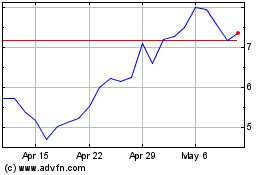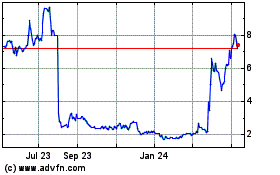Mesoblast Limited (ASX:MSB) (Nasdaq:MESO) today announced that
the Phase 3 trial of its intravenous product
candidate MSC-100-IV used as front-line therapy in children
with steroid-resistant acute graft versus host disease (aGVHD) had
been successful in a pre-specified interim futility analysis.
Enrollment in the 60-patient open label Phase 3 trial is ongoing
across multiple sites in the United States, trial completion is
expected in the first half of 2017, and commercial launch
activities are underway.
The independent Data Safety Monitoring Board (DSMB) notified
Mesoblast that an interim analysis showed that the predefined
Bayesian futility rule used to determine the probability of the
trial’s success using the trial’s primary endpoint of Day 28
overall response had been passed. The analysis method determined
the likelihood of obtaining a statistically significant treatment
effect at study completion, based on the data observed at this
interim time point.
There are currently no products approved in the United States
for this disease. Japan is the only jurisdiction where this therapy
is available, through Mesoblast’s licensee JCR Pharmaceuticals
Co. Ltd. Based on guidance from the United States Food and
Drug Administration (FDA), Mesoblast believes that positive data
from this Phase 3 trial may be sufficient for filing for
accelerated approval of MSC-100-IV in the United States. Mesoblast
plans to broaden its use in adult patients with high-risk
steroid-refractory aGVHD.
“We are pleased that Mesoblast has attained such an important
milestone in making its product available for the potential
treatment of steroid-refractory acute graft versus host disease, a
serious and life threatening condition that has a very urgent need
for effective therapies,” said Dr Joanne Kurtzberg, the Jerome
Harris Distinguished Professor of Pediatrics and Director of the
Pediatric Blood and Marrow Transplant Program at Duke University
Medical Center and the lead investigator on the ongoing Phase 3
trial.
“Mortality can reach 85% in patients with liver and gut
complications and, outside of Japan, there are currently no
approved therapies available. MSC-100-IV is on the cusp of becoming
an important new treatment option for these patients,” she
said.
The successful outcome of the DSMB interim analysis using
the trial's primary endpoint of Day 28 overall response is
consistent with previously reported results in a
pediatric Expanded Access Program (EAP) in children with
steroid-refractory aGVHD. Results from this program, which
evaluated MSC-100-IV in 241 children, were presented in February
2016 at the American Society of Blood and Marrow Transplantation
annual meeting.
Key findings in the EAP program were:
- An overall response rate of 65% in all children at day 28 when
MSC-100-IV was used either as last-line or front-line therapy after
steroid failure
- An overall response rate of 81% at day 28 when MSC-100-IV was
used as front-line therapy following steroid failure
- An overall response rate of 65% and 62%,
respectively, in patients with gastrointestinal and
liver disease, who have the highest mortality risk
- A significantly improved survival at day 100 in
children who achieved overall response at day 28 (82% vs.
39%, log rank p-value <0.0001)
In February 2016, Mesoblast's licensee JCR launched
TEMCELL® HS. Inj. in Japan, the first allogeneic
cell-based product to receive full approval in the world’s
second-largest standalone healthcare market. A four-week,
multi-dose treatment course of TEMCELL for an average adult is
expected to be reimbursed by the Japanese Government’s National
Health Insurance body at a minimum of ¥13,898,880 (approximately
US$130,000) or up to ¥20,848,320 (approximately US$195,000) if
symptoms persist and additional dosing is required. Under its
agreement with JCR, Mesoblast is entitled to receive royalties and
other payments at predefined thresholds of cumulative net
sales.
About Graft Versus Host
DiseaseMesoblast is developing MSC-100-IV for the
treatment of aGVHD following an allogeneic bone marrow transplant
(BMT). In patients who have received a BMT, donor cells may attack
the recipient (the person receiving the transplant), causing aGVHD,
resulting in activation of pro-inflammatory T-cells and tissue
damage in the skin, gut and liver, which is often fatal.
According to the Center for International Blood and Marrow
Transplant Research, there are approximately 30,000 allogeneic BMTs
globally per year for diseases including hematological cancers,
with 25% of all cases in the pediatric population. Nearly 50% of
all allogeneic BMT patients develop aGVHD. Liver or
gastrointestinal involvement occur in up to 40% of all patients
with aGVHD and are associated with the greatest risk of death, with
mortality rates of up to 85%.
Conference CallDr Kurtzberg and Mesoblast’s
Chief Medical Officer, Dr Donna Skerrett, are participating in a
corporate update conference call beginning at 9:00 am Australian
Eastern Daylight Time on Tuesday, November 15, 2016 / 5:00 pm
Eastern Time on Monday, November 14, 2016.
To access the call, dial 1 800 558 698 (toll-free Australia), 1
855 881 1339 (toll-free US), or +61 2 9007 3187 (outside of
the US and Australia).
The conference identification code is 912575.
The live webcast can be accessed via:
http://webcasting.boardroom.media/broadcast/58214386d5f1311b35bd36a6
There will be a slide presentation. Please log in approximately
15 minutes prior to the scheduled start time.
About MesoblastMesoblast Limited (ASX:MSB)
(Nasdaq:MESO) is a global leader in developing innovative
cell-based medicines. The Company has leveraged its proprietary
technology platform, which is based on specialized cells known as
mesenchymal lineage adult stem cells, to establish a broad
portfolio of late-stage product candidates. Mesoblast’s allogeneic,
‘off-the-shelf’ cell product candidates target advanced stages of
diseases with high, unmet medical needs including cardiovascular
diseases, immune-mediated and inflammatory disorders, orthopedic
disorders, and oncologic/hematologic conditions.
Forward-Looking StatementsThis press release
includes forward-looking statements that relate to future events or
our future financial performance and involve known and unknown
risks, uncertainties and other factors that may cause our actual
results, levels of activity, performance or achievements to differ
materially from any future results, levels of activity, performance
or achievements expressed or implied by these forward-looking
statements. We make such forward-looking statements pursuant to the
safe harbor provisions of the Private Securities Litigation Reform
Act of 1995 and other federal securities laws. Forward-looking
statements should not be read as a guarantee of future performance
or results, and actual results may differ from the results
anticipated in these forward-looking statements, and the
differences may be material and adverse. You should read this press
release together with our risk factors, in our most recently filed
reports with the SEC or on our website. Uncertainties and risks
that may cause Mesoblast's actual results, performance or
achievements to be materially different from those which may be
expressed or implied by such statements, and accordingly, you
should not place undue reliance on these forward-looking
statements. We do not undertake any obligations to publicly update
or revise any forward-looking statements, whether as a result of
new information, future developments or otherwise.
For further information, please contact:
Julie Meldrum
Global Head, Corporate Communications
Mesoblast Limited
T: +61 3 9639 6036
E: julie.meldrum@mesoblast.com
Schond Greenway
VP, Investor Relations
Mesoblast Limited
T: +1 212 880 2060
E: schond.Greenway@mesoblast.com
Mesoblast (NASDAQ:MESO)
Historical Stock Chart
From Mar 2024 to Apr 2024

Mesoblast (NASDAQ:MESO)
Historical Stock Chart
From Apr 2023 to Apr 2024
